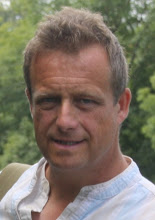
Small brook, Knighton; rocks and water all that remain of my images.
Notes from a walk through Knighton, a journey to collect ideas for a monologue for the Serendipity Festival in July, when I hope to have a short piece performed as part of a walk of historical monologues through the town. This kind of work overlaps areas of interest for me; urban exploration and 'urban aesthetics', inner journeys and stories and (in this case) family history; my monologue will have something to do with my mother's family visiting relatives here - but I don't know when or why.
I have written about Knighton before in this blog but this was my first deliberate exploratory visit. I took a lot of notebook-photographs - narrow Gothic doorways, dust, buried windows - but almost nothing came out. That's what comes of using a camera you don't understand!
The steep slate roofs, white paintwork and old rustic stone of the railway station, now a vet's. A warm, still afternoon. The river Teme, shallow, peat-stained, clear and swift, running beneath the road. Yellow brick and red brick houses, thick with dust, unwashed windows, the dust-becoming-earth of busy roads. A smaller brook rushing to join the Teme, many small bridges, a stream full of blossom. A dipper.
Brookside Square, once the site of the police station. A 1977 Jubilee bench, paint rubbed and wood smoothed by countless bottoms, visitors, resters. The war memorial, Turners and Ellises and Wagstaffs, names tumbling through the town's history like leaves. reminded me of William Eyton Jones (my grandfather) probably knowing the men commemorated on the war memorial in Llangollen.
Mrs Dalloway, a story told as an internal monologue; a model for this piece.
A journey through a town suggestive of lives and families passing through a town, as if the walk took decades.
Ernest's family in a 1930s suburban house, waiting for tea; tablecloths, silver, wiped plates, cake, dusk, anxiety.
Sunshine. What year were they here? What time of year? Why did they come?
Cigarette smoke on the breeze.
Welsh architecture - whitewashed walls and black woodwork. The solidity of Welsh Victoriana. Knighton as a town surrounded by steep fields and thick woods.
How busy were the streets? Less vehicle traffic, more people? Streets of muddy farmers, their rolling gait, as if unused to dry land.
The Clock Tower and up the Narrows to Castle Road, loops through the quiet part to Nelson Square. Barns, stables, stone workshops - agricultural buildings buried into the fabric of the later town. This part reminded me of St Ives; silent streets, cool sunshine, a high blue sky. Whitewashed houses with blue/pale green or black woodwork. An art shop/gallery.
Poppies.
Dappled light on the page, sunshine through young leaves. Sunlight.
A jumble of narrow, twisting streets, tumbled slate roofs, chimney pots. Jackdaws swinging on the wind, stretching down to the highest chimney pot.
A ruffle of Welsh and English names, as indistinct as borders, as impersonal, as meaningless.


